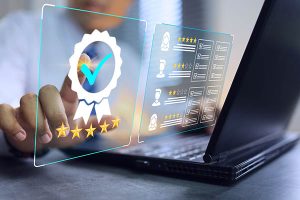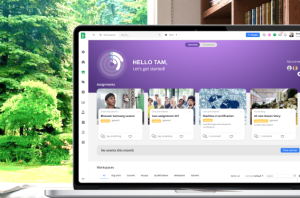Despite advancements in communication methods and software infrastructures, remote learning has yet to become a central work tool for most organizations. The article provides insights into this issue and offers potential solutions.
The COVID-19 pandemic suddenly imposed remote learning across a multitude of industries. There were no more commutes and in-person lectures. For some organisations, this proved to be a complete success and they’ve continued to roll out remote learning. There are many benefits such as providing education to everyone; there’s no limitation based on who is commutable to an office or headquarters.
Remote learning often comes with some technical difficulties. It’s important to not make immediate decisions from an uncertain mindset. Orderly planning processes allow remote working to be a success.
Remote learning is simply synchronous learning, and this concept is nothing new. By this, we mean a learning event where students are learning at the same time with webinars, online classes, video content, and more. This form of learning has been around for decades, essentially since the introduction of the internet. The pandemic has accelerated synchronous learning, but essentially hasn’t introduced anything new. Over the years, we’ve seen great innovations in communication methods and software infrastructures, while remote learning and the work practices around this have essentially stayed the same. They haven’t taken their rightful place as a central work tool for the majority of organisations. This article will take a look at why this is and also offer some solutions to these.
What are the current problems with synchronous learning?
Unfortunately, synchronous learning has some inherent and unique problems. It may intensify any problems you have in your conventional training and learning processes:
- Reliance on a strong internet bandwidth – This is one of the most basic problems that arise with remote learning. If there is not enough bandwidth, continuous learning is not possible.
- Learning through screens – We all learn in different ways. For example, some people thrive being in person with other students, listening to the questions they ask. Everyone has an attention limit when it comes to learning through computer screens or even their smartphone. For some people, for cognitive or physiological reasons, they are unable to maintain attention in front of screens for more than a few minutes. They may struggle to keep up with the pace of other students.
- Increased distractions and reduced productivity for certain people – Similar to the point above, remote learning can intensify existing problems. For example, you may have a learner who requires special attention from the instructor, it’s challenging to provide this care and support to them remotely to accelerate their learning. Or perhaps you have learners who are affected by distractions, they will encounter them significantly more during online distributed learning.
- Struggles in building relationships – An effective learning process requires frequent interactions between the lecturer and the learners. The benefit of this relationship is the lecturer can gauge how their learners are absorbing the material. Who is struggling? What topics can we speed through and what topics require more time invested? It benefits the learners too because they can have their questions answered instantly, and they receive continuous feedback.
In synchronous learning processes, that interactive side of learning is reduced. It’s hard to know who your students are and there’s limited personal feedback. Learning becomes passive, where the multi-users synchronous lessons function at the same as watching learning videos on your own.
- The limitations of timing and location – Often the learners can’t all be present at the same time for the online lessons, or they don’t have enough time to participate in them all. In this case, they won’t be able to learn at all.
What methodology is needed for synchronous learning?
Synchronous learning is key for organisational learning processes however it’s usually one part of a whole network of tools that enable remote learning to be a success. The key word in organisational learning methodology is “ blending learning”. This is assimilated in five layers:
- Online learning
- Recording content and converting content to a streaming format
- Quick conversion of the reading to the e-learning modules
- Control and introducing monitoring capabilities
- Integration of e-learning with additional training tools
First layer: Online learning
There are a wide variety of tools on the market that enable online learning. Most of these tools have similar basic functionality. This functionality is screen sharing, video sharing, table sharing, file sharing, instant messaging, polls, and Q & A. However, different tools differ in exact pricing and capabilities.
To achieve the most effective learning processes online you need to go above and beyond a basic layer of synchronous learning. This basic layer will work if your users are widely dispersed geographically and there is a limited need to hold short online learning or meetings for up to half an hour. If you know your online learning will use up more time, you need to take the next stage by adding additional layers.
Second layer: Recording and converting content to a streaming format
Some of the tools on the market include a built-in option to record your online classes and then convert them to a streaming format using a dedicated server for the subject.
This is a simple but very effective capability because it allows learners to tailor their learning around their existing commitments. They can learn by themselves at a pace that is suitable for them. This is especially beneficial for businesses with employees split across different shift patterns or different skills levels based on hierarchy.
However, this method of learning is very anti-social and doesn’t allow interactive capabilities or that one-to-one feel that traditional learning processes provide. Self-learning has been proven to be more ineffective due to the lack of feedback students receive. It’s passive learning. To improve the effectiveness of learning, we advise you to consider the third layer.
Third layer: Effectively convert existing lessons into effective e-learning products
You don’t need to start from the beginning to create effective e-learning content. With any existing material in video form, you can save time. We recommend that during the conversion process, you maintain maximum focus, and not invest precious time into graphics and animations that don’t contribute to the ultimate effectiveness of the learning experience. Instead, you should invest that time into creating interactions and offering feedback.
Here’s our proposed work method to convert existing video records into effective e-learning modules:
- Build pauses into your lesson planning
- Add interactions and activation sessions at each stopping point
- Provide feedback for each activity
As a result of this, you’re left with multiple short videos which are separate from each other through different engaging activities that are accompanied by feedback. This helps the learner to fully engage with the topic and helps them retain what they learnt. Learning in smaller segments is much more beneficial for our comprehension and retention.
Fourth layer: Review command and control capabilities
When distributing online learning, this can involve a loss of control of the process managers. You’re not engaging with your students in the same space, at the same time, so it’s hard to gauge how your students are responding to your modules and content.
It’s important to allow a simple and effective set of tools for command and control. These tools should be integrated into dashboards for managers. Using these tools, it’s possible to immediately understand the difficulties in your learning processes at any required level: the level of the learner, the level of the content, the level of the study group, and more.
Fifth layer: Combining e-learning with additional training tools
In most organisations, learning and work processes are carried out in a variety of methods:
- Face to face
- E-learning
- Courses
- Training
- Apprenticeships
- Onboarding
- Team learning processes
- Employee evaluation processes
- Informal learning processes between colleagues
It’s very important that all the layers we have described become integral parts of the organisational training system and are involved with the above methods of learning.
With our guidelines, you can make remote learning a success by understanding how humans best learn. There is a great need for synchronous learning to be advanced just like how software and communication methods have advanced over the last decade. The priority should be user engagement and creating opportunities to gather feedback and spark interaction.
Blossom’s blog contains more tips and information from the digital world for complete organisational management.








